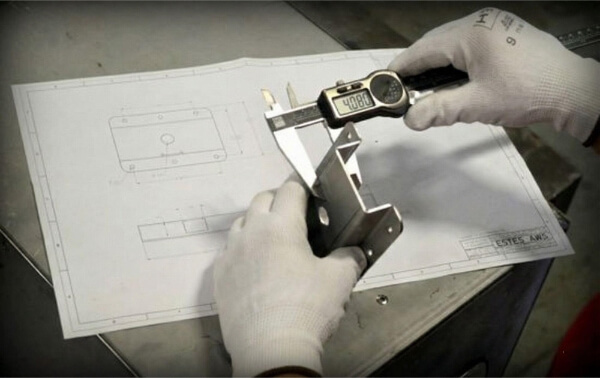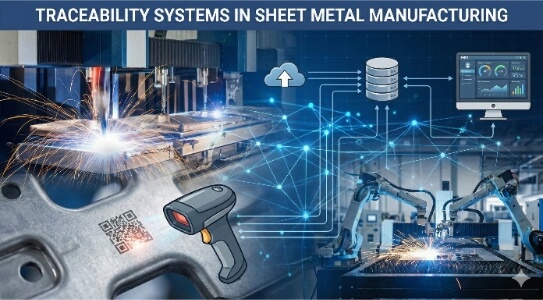Les pièces métalliques sont constamment menacées par la rouille et la corrosion, ce qui entraîne des remplacements et une maintenance coûteux. Les revêtements protecteurs traditionnels sont souvent insuffisants, s'usant rapidement ou offrant une couverture inadéquate. Le revêtement Dacromet résout ces problèmes grâce à sa formulation unique à base de zinc et d'aluminium, offrant une protection supérieure dans diverses applications industrielles.
Vous voulez savoir comment cette technologie de revêtement avancée peut prolonger la durée de vie de vos pièces et réduire les coûts de maintenance à long terme ? Examinons les détails techniques, les avantages et les meilleures applications du revêtement Dacromet.
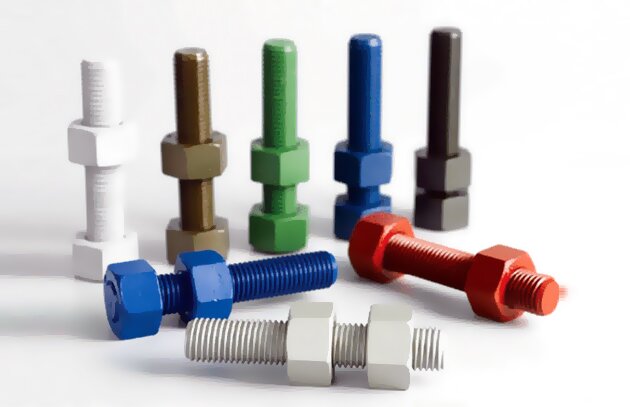
Qu'est-ce que le revêtement Dacromet ?
Le revêtement Dacromet combine des paillettes de zinc, de la poudre d'aluminium et des composés inorganiques dans une solution à base d'eau. Ce système de revêtement avancé forme une barrière multicouche grâce à un processus d'application précis par immersion et rotation, suivi d'un durcissement à haute température.
Il s'agit en quelque sorte d'un bouclier pour les surfaces métalliques, mais un bouclier plus intelligent que les revêtements traditionnels. Le processus commence par le trempage des pièces dans le mélange de revêtement, leur rotation pour assurer une couverture uniforme, puis le durcissement à environ 300°C. Une couche protectrice d'environ 7 à 8 μm d'épaisseur est ainsi créée.
Les particules de zinc agissent comme des gardiens sacrificiels, subissant les effets des éléments corrosifs avant d'atteindre le métal de base. Pendant ce temps, les paillettes d'aluminium créent une barrière physique, et le liant inorganique verrouille le tout en place tout en contrôlant l'action sacrificielle du zinc.
Types de revêtements Dacromet
Des applications différentes exigent des niveaux de protection différents et des caractéristiques de performance spécifiques. Les fabricants proposent plusieurs variantes du revêtement Dacromet, chacune étant conçue pour des utilisations et des conditions environnementales particulières.
La couche de base est la fondation, composée de paillettes de zinc-aluminium mélangées à des liants spécialisés pour créer une couche protectrice de couleur argentée. Cette formule de base prépare le terrain pour des revêtements plus spécialisés.
Voici un aperçu des principaux types d'appareils :
Série Dacromet :
- 310/320: Parfait pour fixations et ressortsen utilisant une formulation à base de chrome hexavalent
- 500: Propriétés autolubrifiantes, idéales pour les composants automobiles et éoliens
Série Geomet (sans chrome) :
- 720: Conçue pour les fixations et les pièces automobiles, utilisant une technologie à base de silicates
- 321: Offre une protection fiable pour les applications dans les secteurs de la construction et de l'automobile
- 500: Comprend des propriétés autolubrifiantes pour réduire les frottements
- 320/360: Contient une plus grande quantité d'aluminium pour une meilleure résistance à la chaleur, spécialement conçu pour les composants de freinage.
Le processus de revêtement Dacromet
La transformation de pièces métalliques brutes en composants résistants à la corrosion nécessite un contrôle précis et un équipement spécialisé. Un processus de revêtement réussi exige une attention particulière aux matériaux, aux méthodes d'application et aux mesures de contrôle de la qualité.
Matériaux utilisés pour le revêtement de Dacromet
Le choix des matériaux appropriés est essentiel pour créer un revêtement Dacromet efficace. Chaque composant joue un rôle spécifique dans la couche protectrice finale.
Le matériel de base comprend
- Paillettes de zinc : Inhibiteur de corrosion primaire
- Poudre d'aluminium : améliore les propriétés de barrière
- Liants inorganiques : Bloquent les particules métalliques en place
- Additifs spécialisés : Contrôle de la viscosité et de l'écoulement
- Supports à base d'eau : Permettent une distribution uniforme
Processus étape par étape de l'application du revêtement Dacromet
Le processus de revêtement suit une séquence précise :
Préparation de la surface
- Nettoyer soigneusement les pièces pour éliminer les huiles et les contaminants
- Sablage ou traitement chimique des surfaces pour une adhérence optimale
- Contrôler la propreté et le profil de la surface des pièces
Application du revêtement
- Tremper les pièces dans la solution Dacromet
- Essorer à des vitesses contrôlées pour assurer une couverture uniforme
- Permettre un séchage initial à l'air dans des conditions contrôlées
Processus de durcissement
- Chauffer les pièces à environ 300°C
- Maintenir la température pendant une durée déterminée
- Refroidissement dans des conditions contrôlées
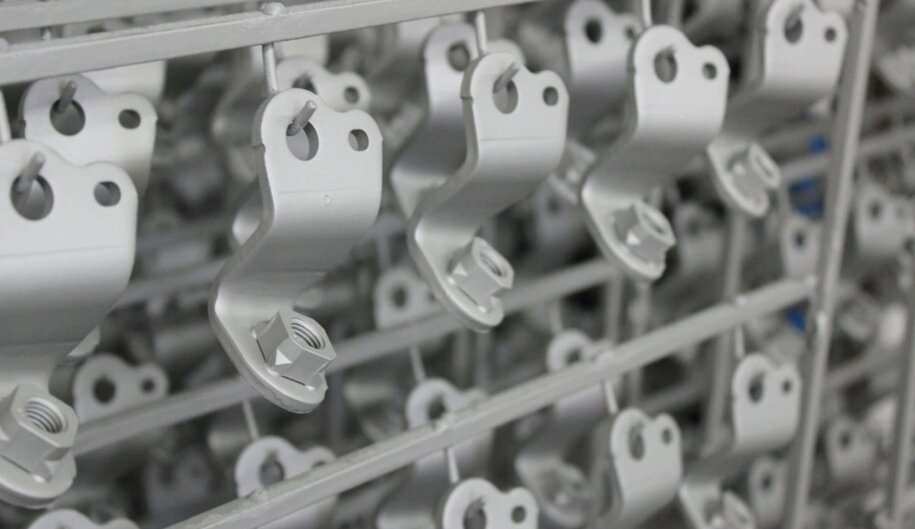
Avantages du revêtement Dacromet
La technologie de protection des métaux continue d'évoluer et le revêtement Dacromet se distingue par ses nombreux avantages. Cette section présente les principaux avantages qui font de Dacromet un choix privilégié pour la protection des métaux dans toutes les industries.
Résistance améliorée à la corrosion
Le revêtement Dacromet crée de multiples barrières contre les éléments corrosifs grâce à sa structure unique en couches. Les paillettes de zinc-aluminium forment un bouclier impénétrable qui bloque la pénétration de l'humidité, du sel et des produits chimiques.
Principales caractéristiques de protection :
- Résiste à plus de 1 000 heures d'essais au brouillard salin
- Prévient la formation de rouille rouge
- Résiste à l'exposition aux produits chimiques en milieu industriel
Durabilité et longévité accrues
La structure multicouche du revêtement Dacromet prolonge considérablement la durée de vie des composants. Cette durabilité se traduit par une réduction de la fréquence de remplacement et des coûts de maintenance.
Mesures de performance :
- Durée de vie de plus de 20 ans dans des conditions normales
- Haute résistance à l'usure
- Forte adhérence aux métaux de base
Résistance aux températures élevées
Le Dacromet conserve ses propriétés protectrices dans une large gamme de températures. Cette stabilité à la chaleur le rend approprié pour les composants exposés à des cycles thermiques.
Performance en matière de température :
- Stable jusqu'à 300°C (572°F)
- Pas de ramollissement ni de fissuration sous l'effet de la chaleur
- Maintien de l'adhérence en cas de fluctuations de température
Aspects écologiques du revêtement Dacromet
Le processus de revêtement est conforme aux normes environnementales modernes. Sa formulation à base d'eau et ses méthodes de production réduisent l'impact écologique.
Avantages verts :
- Zéro émission de COV
- Conforme aux normes REACH et RoHS
- Pièces revêtues recyclables
Peu d'entretien
Une fois appliqué, le revêtement Dacromet ne nécessite qu'un entretien minimal. Les propriétés auto-cicatrisantes du zinc assurent une protection continue sans entretien régulier.
Avantages en termes d'entretien :
- Aucun recouvrement périodique n'est nécessaire
- Réparation automatique des rayures mineures
- Maintien de l'aspect au fil du temps
Inconvénients du revêtement Dacromet
Un attrait esthétique limité
Le revêtement produit une finition grise et mate qui peut ne pas convenir à toutes les applications. Par rapport à d'autres types de revêtement, les options de couleur restent limitées.
Vulnérabilité aux dommages mécaniques
Malgré ses qualités protectrices, le revêtement Dacromet peut être endommagé par des chocs violents ou par l'abrasion. Des objets pointus ou des charges lourdes peuvent également compromettre l'intégrité du revêtement.
Temps de durcissement plus long que les autres revêtements
Le processus d'application multicouche exige des conditions et un temps de durcissement spécifiques. Cela allonge les délais de production par rapport à des méthodes de revêtement plus simples.
Risque d'irrégularité de l'épaisseur du revêtement
La technique d'application affecte l'uniformité du revêtement. Les géométries complexes des pièces peuvent entraîner des variations d'épaisseur qui ont un impact sur les niveaux de protection.
Coût initial de l'application plus élevé
L'équipement spécialisé et le contrôle du processus requis pour le revêtement Dacromet entraînent des coûts initiaux plus élevés. Cet investissement initial doit être mis en balance avec les avantages à long terme.
Applications du revêtement Dacromet
Le revêtement Dacromet est utilisé dans de nombreuses industries où la protection des métaux contre les environnements difficiles est cruciale. Cette solution de revêtement polyvalente répond à des exigences de performance spécifiques dans divers secteurs, de l'automobile à la marine.
Applications de l'industrie automobile
Le secteur automobile fait largement appel au revêtement Dacromet pour protéger les composants critiques du sel de déneigement, de l'humidité et de l'exposition à l'environnement. Ce revêtement aide les fabricants à respecter des normes de durabilité rigoureuses tout en réduisant les réclamations au titre de la garantie.
Applications automobiles courantes :
- Composants du système de freinage
- Pièces de suspension
- Fixations du châssis
- Supports de montage du moteur
- Composants du système d'alimentation en carburant
Utilisations aérospatiales et militaires
Dans les applications aérospatiales et de défense, le revêtement Dacromet répond à des spécifications de performance strictes. Le revêtement protège les composants exposés à des conditions extrêmes et à des climats variables.
Principales utilisations militaires et aérospatiales :
- Fixations structurelles
- Composants du train d'atterrissage
- Matériel externe
- Équipement de soutien au sol
- Supports de montage
Projets de construction et d'infrastructure
L'industrie de la construction apprécie le revêtement Dacromet pour sa protection à long terme des composants structurels. Ce revêtement contribue à prolonger la durée de vie des infrastructures dans des environnements difficiles.
Les applications dans le domaine de la construction comprennent
- Composants du pont
- Garde-corps d'autoroute
- Attaches de construction
- Structures de soutien
- Joints de dilatation
Applications marines
Les environnements marins exigent une protection supérieure contre la corrosion. Le revêtement Dacromet offre une excellente résistance au brouillard salin et à une exposition constante à l'humidité.
Le secteur maritime utilise :
- Quincaillerie de pont
- Équipement portuaire
- Plateformes offshore
- Accastillage de navire
- Composants du conteneur
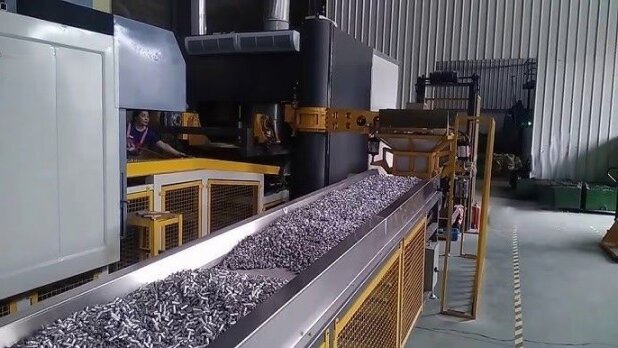
Revêtement Dacromet vs. Revêtement en zinc
Faire le bon choix entre les options de revêtement affecte à la fois les performances et les coûts. Cette comparaison aide les décideurs à sélectionner la solution la plus adaptée à leurs besoins spécifiques.
Différences essentielles en matière de résistance à la corrosion
Les deux méthodes de revêtement offrent différents niveaux de protection contre les environnements corrosifs. Les essais montrent des variations de performance distinctes dans des conditions difficiles.
Comparaison de la résistance à la corrosion :
- Dacromet : Résistance au brouillard salin pendant plus de 1 000 heures
- Placage de zinc : 200-300 heures de résistance au brouillard salin
Mécanismes de protection :
- Le Dacromet crée plusieurs couches de barrière
- Le zingage repose sur une protection sacrificielle
- Les risques d'exposition aux métaux de base diffèrent sensiblement
Rapport coût-efficacité
Les coûts initiaux et la valeur à long terme présentent différents scénarios économiques pour chaque type de revêtement. Une analyse approfondie révèle l'impact réel des coûts au fil du temps.
Facteurs de coût à prendre en considération :
Dacromet :
- Investissement initial plus élevé
- Réduction des coûts de maintenance
- Durée de vie prolongée
Placage de zinc :
- Des coûts initiaux moins élevés
- Un recouvrement plus fréquent est nécessaire
- Augmentation des dépenses à long terme
Comparaison de la durabilité et des performances
Les performances réelles diffèrent considérablement entre ces options de revêtement. Les conditions environnementales et les exigences d'application influencent la longévité du revêtement.
Mesures de performance :
Résistance à la température :
- Dacromet : Jusqu'à 300°C
- Placage de zinc : Jusqu'à 120°C
Cohérence de l'épaisseur :
- Dacromet : Couverture uniforme
- Placage de zinc : Accumulation variable
Résistance aux chocs :
- Dacromet : Flexibilité modérée
- Placage de zinc : Plus fragile
Résistance chimique :
- Dacromet : Haute résistance
- Placage de zinc : Résistance modérée
Conclusion
Le revêtement Dacromet prouve sa valeur grâce à une protection supérieure contre la corrosion et à des avantages financiers à long terme. Si l'investissement initial peut être plus élevé, la durée de vie prolongée et la réduction de la maintenance en font un choix judicieux pour les applications exigeantes. La conformité environnementale du revêtement et son expérience éprouvée dans tous les secteurs en font une solution fiable pour relever les défis de la fabrication moderne.
Au-delà du revêtement Dacromet, nous offrons des solutions complètes de fabrication sur mesure pour tous vos besoins. Grâce à un équipement de pointe et à une équipe technique professionnelle, nous pouvons répondre à vos diverses exigences dans les domaines suivants Usinage CNC, fabrication de tôleset bien plus encore. Choisissez-nous pour rendre votre processus de fabrication plus efficace et plus transparent.
FAQ
Quelle est la durée de vie du revêtement Dacromet ?
Dans des conditions normales, le revêtement Dacromet dure généralement de 20 à 25 ans. La durée de vie réelle dépend de l'exposition à l'environnement et des conditions d'application. Des inspections régulières permettent de contrôler les performances du revêtement au fil du temps.
Le revêtement Dacromet peut-il être appliqué sur tous les matériaux ?
Le revêtement Dacromet fonctionne le mieux sur les substrats en acier et en fer. Bien qu'il puisse être appliqué sur d'autres métaux, le processus de revêtement nécessite des conditions de surface et des méthodes de préparation spécifiques pour garantir une bonne adhérence.
Le revêtement Dacromet est-il sans danger pour l'environnement ?
La formulation à base d'eau ne contient ni métaux lourds ni solvants nocifs. Le revêtement Dacromet est conforme aux réglementations environnementales en vigueur dans le monde entier, y compris les normes REACH et RoHS. Le processus produit un minimum de déchets et d'émissions.
Dacromet contient-il du chrome hexavalent ?
Non, le revêtement Dacromet ne contient pas de chrome hexavalent. Il utilise plutôt des composés de chrome trivalent, ce qui le rend conforme aux normes modernes en matière d'environnement et de sécurité.
Quelle est l'épaisseur du revêtement de Dacromet ?
L'épaisseur standard du revêtement Dacromet varie de 5 à 15 microns. L'épaisseur exacte dépend des exigences de l'application et du niveau de qualité spécifié. Des mesures de contrôle de la qualité garantissent une épaisseur de revêtement constante sur toutes les pièces.
Hey, je suis Kevin Lee

Au cours des dix dernières années, j'ai été immergé dans diverses formes de fabrication de tôles, partageant ici des idées intéressantes tirées de mes expériences dans divers ateliers.
Prendre contact

Kevin Lee
J'ai plus de dix ans d'expérience professionnelle dans la fabrication de tôles, avec une spécialisation dans la découpe au laser, le pliage, le soudage et les techniques de traitement de surface. En tant que directeur technique chez Shengen, je m'engage à résoudre des problèmes de fabrication complexes et à favoriser l'innovation et la qualité dans chaque projet.

